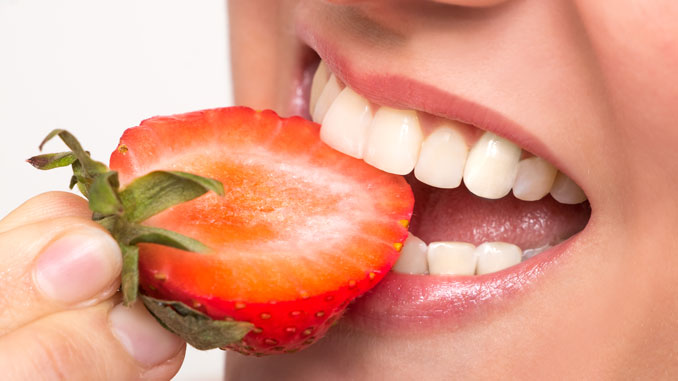
Leafy Greens
Vegetables that are juicy and leafy are some of the best foods for your teeth. Cabbage, Swiss chard, spinach, kale, lettuce, and collard greens are all great choices. Each is loaded with vitamins and minerals that are necessary to help maintain and improve your oral health. The nutrients found in dark leafy vegetables like spinach and lettuce contain high amounts of magnesium, vitamin A, vitamin C, beta carotene, calcium, and magnesium. Because phosphorous is stored in the teeth (your bones), these minerals are helpful in maintaining overall body balance.
Carrots, Celery, and Root Vegetables
Munching on carrots and celery is a great way to keep your teeth healthy. When you chew foods that are crunchy and high in fiber, they not only stimulate the gums, but also help generate mouth cleansing saliva. Strong, healthy gums are important to keeping teeth healthy, too. Not to mention, these foods are also good sources of beta-carotene, which your body needs to create vitamin A , a nutrient essential for building strong teeth.
Citrus
Citrus fruits are good for oral health because they have a large amount of vitamin C. Chewing fiber-rich, fresh fruits massages gums, helps clean teeth, and increases salivation, which can neutralize the citric and malic acids that citrus fruits leave in your mouth. Our favorite fruit choices are oranges, pears, and watermelons. And be sure your diet includes citrus and other fresh fruits rich in vitamin C, such as apples, pears, strawberries, pineapples, tomatoes, and cucumbers –all rich in vitamin C.
Apples
You know that eating an apple a day can keep the doctor away. Well, this includes the dentist, too. Apples, which dentists like to call ‘nature’s toothbrush’, are a great snack because they are fibrous. Eating an apple can help clean teeth until you brush and floss. Try to avoid apple juice, however, because the added sugar can contribute to tooth decay. Enjoying a fresh apple though can stimulate gums and reduce cavity- causing bacteria that builds up in the mouth.
Berries
Cranberries, blueberries, raspberries, and other plant foods rich in antioxidants may prevent the attachment and colonization of bacteria and pathogens on teeth. Compounds found in cranberries have actually been linked to disrupting the enzymes associated with the bacteria-forming process that leads to plaque and tooth decay.

Functional Foods for Good Dental Health
Research has shown that a healthy diet that contains so-called ‘functional foods’ can benefit our oral and general health. Functional foods are foods that have a potentially positive effect on health beyond basic nutrition. Basically, these foods can promote optimal health while simultaneously helping to reduce the risk of disease. Here is how to get the most out of functional foods to promote good oral health.
Timing is Important
A diet that promotes good oral health is not just about the foods you eat or avoid — when and how you eat them is just as important. One way to protect your teeth is by eating raw/fresh foods at the end of meals. This helps to clean teeth and massage gums while generating more saliva to wash away extra food particles left after a meal.
The order in which you consume food and beverages, dubbed “food sequencing,” is extremely important and may help to prevent tooth decay. Try eating acid neutralizing foods after acidic foods or sweets to help prevent prolonged acid attacks to your teeth and help prevent cavities. The best examples are dairy products, melons, green vegetables, and healthy fats. Also, be sure to drink plenty of water during and after meals to help wash away sugars and acids left from snacks and meals.
Snack Healthier
Instead of snacking on sugary or acidic foods throughout the day, try eating these foods just during meal times in order to minimize the amount of time teeth are exposed to the sugar and/or acid. The body produces more saliva to help digest larger meals, which washes away more food and helps neutralize harmful acids before they can attack teeth. And eating fresh vegetables and fruits after a larger meal can help remove material that has adhered to the surface of your teeth.
SMILE! …and Eat Healthy
A healthy diet means healthy teeth
Prevention is the best medicine for your smile, and dental health is more important than you may realize for overall health. What you eat plays a big role. Today’s nutritional approaches to oral health go beyond watching sugar intake. The foods you choose as well as when and how often you eat them not only affects general health, but also the health of your teeth and gums. The good news is tooth decay is preventable with good oral hygiene, regular dental visits, AND a healthy diet.
While good oral hygiene is critical for keeping our teeth healthy and clean, it isn’t the only factor at play. By eating the right foods and avoiding the wrong ones, you can ward off cavities and reduce your risk of gum disease. Before you make out your next grocery list, learn how to choose the best foods for promoting healthy teeth and gums. Like every other part of your body, your teeth and gums require proper nutrition to function their best. This means getting enough of the right kinds of minerals, which serve as building blocks for your teeth and its protective enamel. At the same time, certain foods also contain natural chemical compounds, which can inhibit the growth of harmful oral bacteria. Dr. Lester Low, DDS, a family and cosmetic dentist in Stockton, stresses the importance of diet, oral hygiene, and oral habits that relate to patients’ overall health. “Things that stain teeth typically are coffee, tea, and wine. While we like all healthy foods, acidic foods are most damaging to teeth. It is important to maintain a balanced diet.” This involves eating a variety of foods from each of the five major food groups.
Fresh Fruits and Vegetables Help Keep Teeth Healthy
Ongoing research indicates that antioxidants and other nutrients found in fruits and vegetables may strengthen immunity and improve the body’s ability to fight bacteria and inflammation, all of which can help protect the teeth and gums. The best foods for healthy teeth are fresh fruits and veggies because of their nutritional and mouth health benefits. For example, crisp fruits and raw vegetables, like apples, carrots, and celery, help clean plaque from teeth and freshen breath. Leafy salad greens contain lots of folic acid, which promotes a healthy mouth and supports cell growth throughout your entire body. Many fruits and vegetable contain lots of antioxidant vitamins, such as vitamin C, that help protect gums, and other tissues from cell damage and bacterial infection. For healthy teeth and gums, look for seasonal fruits and veggies in your local grocery or farmers market.
Timing is everything
A diet that promotes good oral health is not just about the foods you eat or avoid. When and how you eat them is equally important. Foods that take a long time to chew or that you hold in your mouth can damage teeth as they retain sugar in the mouth longer than other foods. Instead of snacking on sugary, carbohydrate-rich, or acidic foods throughout the day, eat these foods just during meal times in order to minimize the amount of time teeth are exposed to acid. In addition, the body produces more saliva to help digest larger meals, which washes away more food and helps neutralize harmful acids before they can attack teeth.
Dr. Caressa Louie, DDS, at Stockton Dental Care explains that from dental perspectives, we would like to regulate the meal/snack time instead of constantly eating all day. “This way we can better control the plaque on our teeth and neutralize the PH of our mouth. When we snack constantly, there is not enough time for the saliva to neutralize the PH of our mouth after eating, and starchy snacks leave tenacious soft plaque on our teeth which contribute to the development of [tooth] decay and periodontal disease.”
What else can help?
When it comes to the health of your teeth, you really are what you eat. Sugary foods, such as candy and soda, contribute to tooth decay. One of the first areas to decline when your diet is less than ideal is your oral health, according to the American Dental Association (ADA). Try making these foods more of a treat instead of a staple in your diet.
Kids love to snack on things like crackers, chips, and candy. The most important thing we can do to help limit the risk of tooth decay is ensure kids develop good oral hygiene habits. If they keep plaque from building up on teeth by brushing and flossing, the risk for decay will still be pretty low. Simply put, if kids get the food debris off of their teeth quickly, they decrease their risk of tooth decay. For toddlers, parents should be brushing and flossing for them. As children age, allow them to brush and floss on their own, but monitor and follow up to make sure all areas of the mouth are clean. Teens need to spend even more time on their oral hygiene each day to limit risk. Teenagers sometimes “forget” to brush so parents need to check to ensure they’re maintaining good oral hygiene.
Just remember to choose sugary foods less often, eat a variety of foods emphasizing fresh fruits and veggies, avoid sugary, carbohydrate-rich, or acidic foods between meals, and brush your teeth with fluoride toothpaste after you eat.
Both kids and adults love to snack, but snacking can pose challenges to keeping teeth healthy. Smart snacking involves both strategic snack-time planning and choosing certain types of foods.
Why is snacking more likely to promote tooth decay?
The bacteria that cause dental cavities feed on any carbohydrate source we eat – sugar, bread, potatoes, rice, crackers, chips, pretzels, gummies, fruit snacks, juice, etc. The bacteria eat the carbohydrates and convert them to an acid. More acid equals an increased risk for cavities. Our saliva can help to cancel out the effects of the acid. However, if we snack throughout the day, the continuous production of acid overwhelms the saliva’s ability to buffer or counteract the acid and cavities are more likely to develop.
What is considered ‘smart snacking’?
Smart snacking is about limiting how often we are snacking in between meals and choosing foods that are better than others in terms of type and texture. It’s better to have the whole snack at one time, rather than a little bit all throughout the day. It’s also helpful to limit snacking on carbohydrates and processed foods as much as possible. According to Dr. Funto Ayanleke, DDS at Children’s Choice Dental Care in Stockton. “We recommend fruits such as grapes, strawberries, and bananas and advise our patients to stay away from sugary drinks and foods that have high sugar content.” Limiting foods that are chewy and sticky helps, too. These foods can get stuck in the grooves of the back teeth and can sit on the teeth for long periods of time increasing the risk for cavities.
What are better snack choices?
- For many reasons, including keeping teeth healthy, whole foods that are minimally processed (like an apple) will always be better than processed carbohydrate-rich foods (like sugar-sweetened applesauce).
- Snacks that are higher in protein and lower in carbohydrates make especially good choices. Nuts and cheese are great in this regard and also help build strong teeth.
- Even though they may contain some sugar, fruits and vegetables are a good choice as they provide many important nutrients. Harder or crunchy options like apples, celery, and carrots are especially good snack choices.

